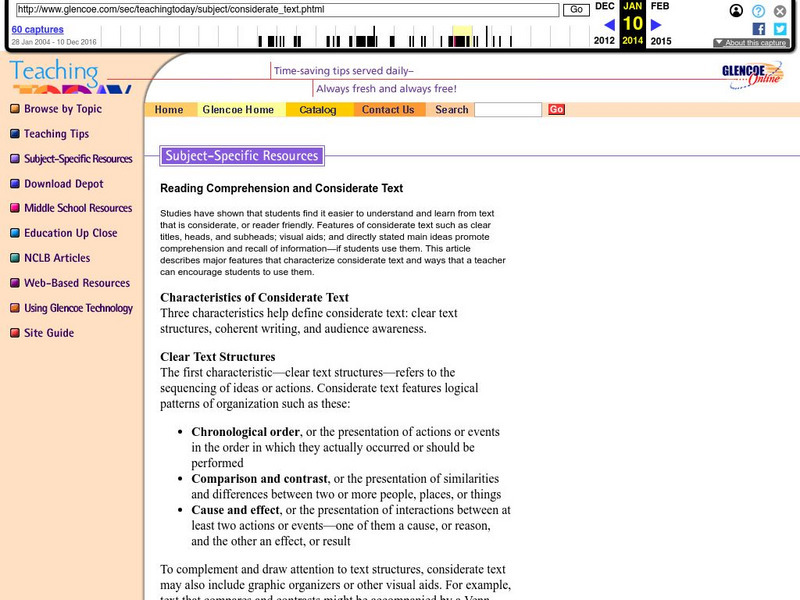Curated OER
Which Came First?
Pupils examine the significance of the Louisiana Purchase and the journey of Lewis and Clark. They sequence events that occurred on the journey of Lewis and Clark.
Curated OER
Most Wanted Villians
Students review the characteristics of various characters in fairytales. As a class, they review the story details and create a concept map using a software program. They create their own wanted poster of the villians in the fairytale to...
Curated OER
Genre Study
Third graders develop an understanding of genre by participating in small- and whole-group activities. In addition, they practice presentation and specific listening skills. This lesson assumes students have been regularly exposed to a...
Curated OER
Tall Tales: Read, Write, Draw and Sing
Students get to know the characters and events that shaped American folktales through writing, drawing and singing activities. Handouts and worksheets are included.
Curated OER
Beyond Louisiana
Eleventh graders examine the challenges that faced United States as a new nation. In this American History lesson, 11th graders study the chronology of events leading up to the expedition of Lewis and Clark. Students organize...
Curated OER
Different Strokes for Different Folks
Fourth graders are taken to the media center to review various genre of literature, apply information and concepts to evaluate examples and locate specific genre, and search for materials for reading enjoyment. A good lesson for genre...
Curated OER
Seeing Is Believing
Learners research and describe the stories of Thomas Jefferson, Meriwether Lewis and William Clark. They analyze historical sources from different points of view and present an analysis of two historical contexts.
Curated OER
Beneath the News: Who's Doing What to Whom, and Who Cares?
Students investigate the differences between various forms of media (print, radio, TV, Internet). They determine the target audience for each and compare exposure around the world. They write a short story and share it with the class.
Quizlet
Quizlet: Non Fiction Text Features 3rd Grade Test
Text feature terms are included in this assessment. This test assesses the following text feature terms: map, table of contents, index, bold words, caption, timeline, heading, and glossary. Images of the text feature terms are included....
South Carolina Educational Television
Know It All: Non Fiction Text Features
Fifth graders will use non-fiction books to identify and explain how text features help them as individual readers.
Quizlet
Quizlet: Non Fiction Text Features 3rd Grade Match
Text feature terms (nonfiction) are included in this review "Match" game. Questions are provided for the following words: map, table of contents, index, bold words, caption, timeline, heading, and glossary. Images of each of these text...
Quizlet
Quizlet: Nonfiction Text Features 3rd Grade Flashcards
Text feature terms (nonfiction) are included in this review exercise Flashcards are provided for the following words: map, table of contents, index, bold words, caption, timeline, heading, and glossary. Images of each of these text...
Scholastic
Scholastic: Teaching With Nonfiction: Teach Text Features
A brief lesson plan, this site offers an example of non-fiction text and a graphic organizer to help orient students to the features they need to use when reading for information.
TES Global
Tes: Non Fiction Unit 4 Formal/impersonal Writing: Tourists
[Free Registration/Login Required] Students will analyze tourism brochures to determine features related to nonfiction writing in this unit. Tourism websites may be used in lieu of the brochures. Cotswold and the North Leigh Roman Villa...
ReadWriteThink
Read Write Think: Text Features: Non Fiction [Pdf]
Compare the printed page to an electronic web page and use this activity to discuss the similarities and differences. A cross-curricular tie-in with ecosystems. Could easily be adapted to another subject area.
Curated OER
Glenco Online: Teaching Today: Reading Comprehension and Considerate Text
Learn the features of "considerate text" and ways to teach students to use these features to increase their comprehension as they read. These features generally apply to non-fiction, especially textbooks.
British Library
British Library: 19th Century Non Fiction Texts: Work & Welfare
This thematic collection will allow students to read and understand 19th-century non-fiction texts, and support them in identifying key features for a range of genres, audiences, and purposes. Each source is accompanied by original...
British Library
British Library: 19th Century Non Fiction Texts: Gender, Behaviour & Etiquette
This thematic collection will allow students to read and understand 19th-century non-fiction texts, and support them in identifying key features for a range of genres, audiences, and purposes. Each source is accompanied by original...
City University of New York
Cuny: E Resource Center: Course Tutorials: Reading Your Textbook
A tutorial consisting of seven exercises showing different text structures used in textbooks. Learn how they organize information to help students locate specific details and how to take notes based on information within a textbook.
Other
Lib.ru: Classic Russian Literature
Great resource for finding online text for classic Russian literature in Russian. Features the most popular writers and their works. Valuable resource for students studying Russian. Russian-speaking ELL students might translate passages...
CommonLit
Common Lit: Units: Teaching Units
Complete teaching units (12) by grade level. CommonLit units are crafted to be both engaging and rigorous, featuring a variety of literary and informational texts from diverse sources. Reading, writing, and discussion are prioritized in...


















